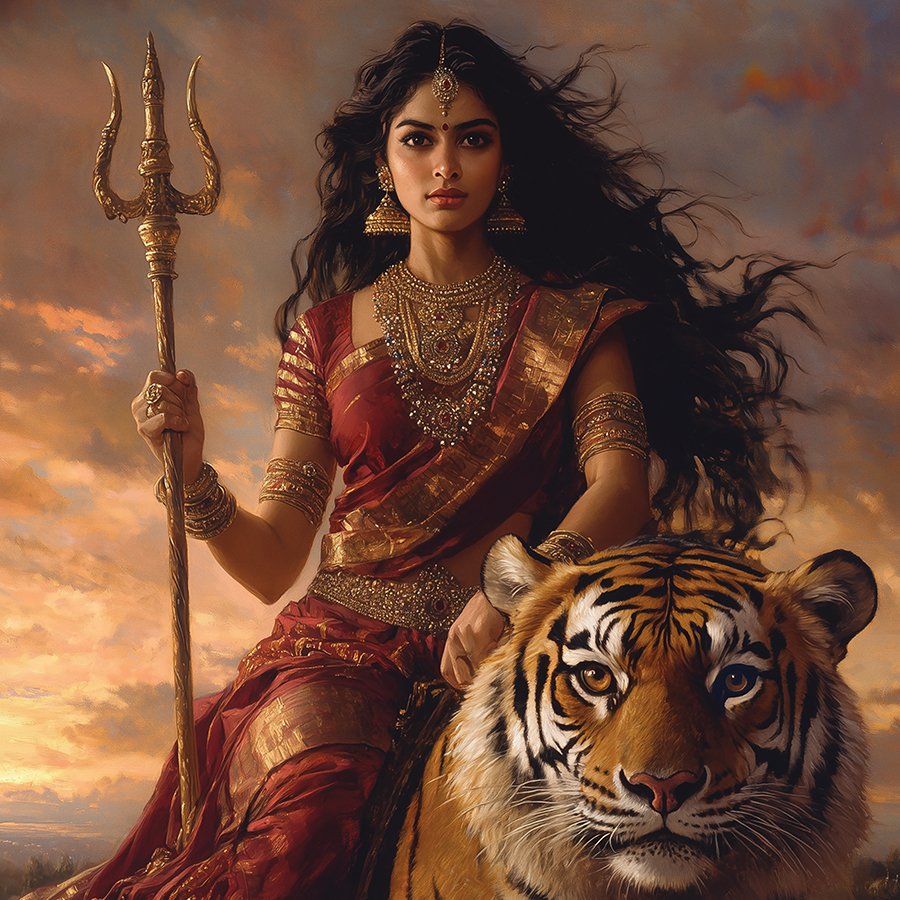Durga
Durga is one of my favorite goddesses in any religion or mythology, and she happens to be one of the most fierce and powerful. Yet she is rarely associated with fear or darkness, but rather with light and salvation. She embodies the ultimate power of the divine feminine and is a spiritual mother to many. She also rides a lion or tiger into her great battles, and as an unapologetic cat lover with every feline as one of my totem animals, I feel naturally compelled toward this fierce and powerful deity. Additionally, as my primary element is fire, I am drawn to goddesses like Durga, Sekhmet, and Freyja, who embody the fiery spirit of transformation and power.
Durga’s story begins in a time of great cosmic turmoil. The demon Mahishasura, who had received a boon from Brahma making him nearly invincible, was causing havoc across the universe. Neither gods nor men could stop him. In their desperation, the gods combined their energies to create a supreme warrior capable of defeating this demon. From this confluence of divine power, Durga emerged, radiant and formidable, embodying the collective might of the deities.
The lion or tiger Durga rides isn’t just for show. The big cat, a gift from Shiva, symbolizes raw power, courage, and the untamed forces of nature. This imagery reflects her mastery over these forces, depicting her ability to harness and control the wildest elements. Riding a lion or tiger also signifies the triumph of good over evil, as these animals embody ferocity and aggression, which Durga, with her divine grace, subdues and guides. Durga’s battle with Mahishasura is legendary. It’s more than just a tale of good versus evil; it’s a powerful allegory for the triumph of righteousness and dharma (cosmic law and order) over adharma (chaos and unrighteousness). For nine days and nights, Durga fought Mahishasura and his army. On the tenth day, known as Vijayadashami or Dussehra, she finally defeated him, restoring peace to the world.
Durga is often depicted with multiple arms, a common feature in Hindu iconography. These arms symbolize her multifaceted nature and omnipotence. Each arm holds a different weapon or item, each bestowed by various gods to signify their combined powers and support. This artistic representation signifies her ability to perform several tasks simultaneously, reflecting the boundless and omnipresent nature of the divine. The weapons she carries are not just for show; each signifies a particular virtue or power that she wields: the sword symbolizes wisdom and knowledge, the bow and arrow represent energy and focus, and the conch signifies the primordial sound of creation, Om.
Durga’s significance extends beyond her role as a warrior goddess. She is also revered as a nurturing mother, embodying the compassionate and protective aspects of motherhood. This duality is seen in her association with Parvati, the gentle consort of Shiva, and as the mother of Ganesha and Kartikeya. This maternal aspect underscores her role as a guardian of the cosmic order, providing not only protection but also guidance and support.
Durga’s worship is deeply embedded in Hindu culture, especially during the festival of Navaratri. This nine-night festival celebrates her nine forms, collectively known as Navadurga, each representing different aspects of the goddess and the virtues she embodies. The tenth day, Vijayadashami, marks her victory over Mahishasura and is celebrated with grand festivities, symbolizing the triumph of good over evil. During Navaratri, temples dedicated to Durga are adorned with vibrant decorations, and elaborate rituals are performed to honor her. In these temples, her statues often depict her in the midst of her battle with Mahishasura, showcasing her bravery and divine power.
Durga’s influence extends beyond Hinduism. Her archetype resonates with warrior goddesses in other cultures, such as the Egyptian Sekhmet and the Norse Freyja. Sekhmet, the lioness-headed goddess of war and healing, and Freyja, the Norse goddess who rides a chariot pulled by cats, both share attributes with Durga. These similarities suggest either direct influence through cultural exchanges or a broader, collective archetype of the divine feminine warrior across different societies.
Spiritually, Durga represents the indomitable force of good, the inner strength that lies within each of us, and the eternal struggle between order and chaos. Her mythology teaches the importance of courage, righteousness, and unwavering faith. She is a reminder that even in the face of insurmountable odds, the divine energy within us can triumph over adversity.
Durga’s legacy is a testament to her enduring relevance. She is a symbol of empowerment, a protector of the righteous, and a beacon of hope. Her story, rich with symbolic meaning and spiritual depth, continues to inspire and guide devotees, encouraging them to embrace their inner strength and uphold the principles of justice and compassion.
Durga is most closely associated with the element of fire. Fire represents transformation, power, and purification, all qualities intrinsic to Durga’s nature. Just as fire can destroy and renew, Durga’s energy is both destructive and regenerative, clearing away the forces of darkness to make way for light and righteousness. Fire’s intensity and ability to sustain life through warmth also mirror Durga’s role as a fierce protector and nurturing mother.
Durga’s story isn’t just an ancient myth. It’s a living narrative that speaks to the enduring power of faith, the importance of courage, and the unwavering belief in the triumph of good over evil. Her legacy, rich with symbolism and spiritual significance, continues to inspire and guide those who seek strength and protection in their own lives.


